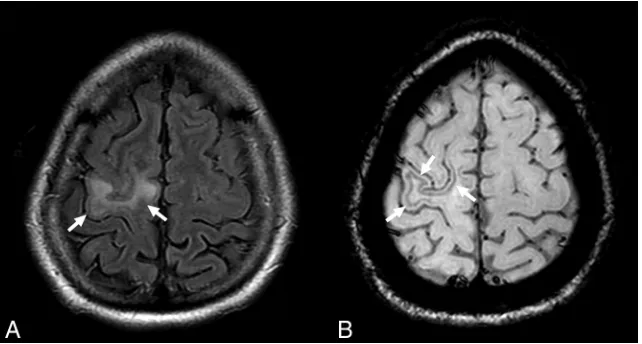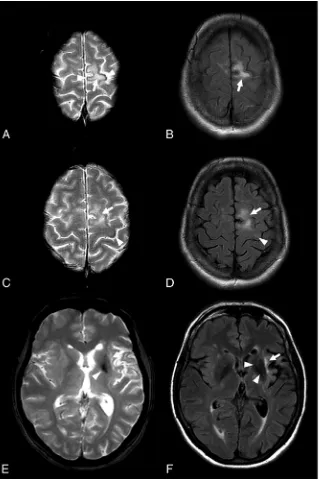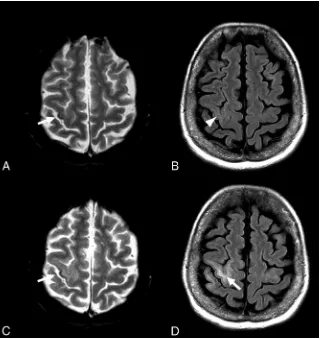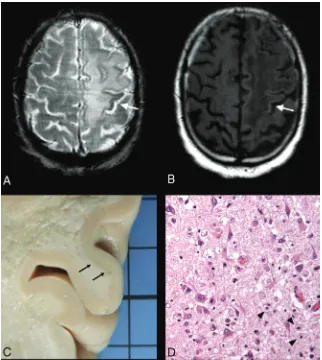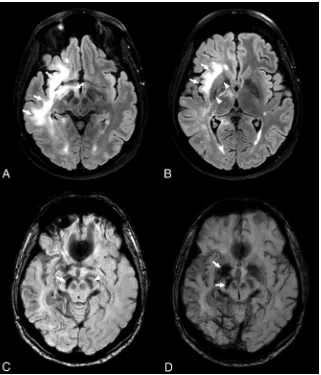CLINICAL REPORT
ADULT BRAIN
Brain Magnetic Susceptibility Changes in Patients with
Natalizumab-Associated Progressive Multifocal
Leukoencephalopathy
J. Hodel, O. Outteryck, S. Verclytte, V. Deramecourt, A. Lacour, J.-P. Pruvo, P. Vermersch, and X. Leclerc
ABSTRACT
SUMMARY: We investigated the brain magnetic susceptibility changes induced by natalizumab-associated progressive multifocal leuko-encephalopathy. We retrospectively included 12 patients with natalizumab–progressive multifocal leukoencephalopathy, 5 with progres-sive multifocal leukoencephalopathy from other causes, and 55 patients with MS without progresprogres-sive multifocal leukoencephalopathy for comparison. MR imaging examinations included T2* or SWI sequences in patients with progressive multifocal leukoencephalopathy (86 examinations) and SWI in all patients with MS without progressive multifocal leukoencephalopathy. Signal abnormalities on T2* and SWI were defined as low signal intensity within the cortex and/or U-fibers and the basal ganglia. We observed T2* or SWI signal abnormalities at the chronic stage in all patients with progressive multifocal leukoencephalopathy, whereas no area of low SWI signal intensity was detected in patients without progressive multifocal leukoencephalopathy. Among the 8 patients with asymptomatic natalizumab– progressive multifocal leukoencephalopathy, susceptibility changes were observed in 6 (75%). The basal ganglia adjacent to progressive multifocal leukoencephalopathy lesions systematically appeared hypointense by using T2* and/or SWI. Brain magnetic susceptibility changes may be explained by the increased iron deposition and constitute a useful tool for the diagnosis of progressive multifocal leukoencephalopathy.
ABBREVIATIONS:NTZ⫽natalizumab; PML⫽progressive multifocal leukoencephalopathy
N
atalizumab (NTZ), an effective treatment in patients with relapsing-remitting multiple sclerosis, is associated with a risk of progressive multifocal leukoencephalopathy (PML).1Earlydiagnosis of NTZ-associated PML (NTZ-PML) may improve the functional outcome.2However, the diagnosis of asymptomatic
NTZ-PML remains difficult due to the coexistence of MS lesions and the different imaging patterns of NTZ-PML lesions.3-5
MR imaging is crucial for the recognition of NTZ-PML.1,4-7
The known imaging findings for asymptomatic NTZ-PML in-clude the following: a subcortical location involving U-fibers, a sharp lesional border toward the gray matter contrasting with an ill-defined border toward the white matter, and increased signal intensity on T2-weighted and diffusion-weighted im-ages.5 Postcontrast enhancement and T2WI hyperintense
punctate lesions have also been reported in patients with NTZ-PML.4,5,8
To our knowledge, there are no data available on the suscep-tibility changes, evaluated by gradient-echo T2* or suscepsuscep-tibility- susceptibility-weighted images, in a cohort of consecutive patients with NTZ-PML. Our purpose was to investigate the brain magnetic susceptibility changes, detected on T2* or SWI, in a cohort of consecutive patients with NTZ-PML.
Case Series
Patients. This retrospective study was approved by our institu-tional review board. From February 2011 to August 2014, 17 con-secutive patients, including 12 patients with relapsing-remitting multiple sclerosis treated with NTZ, 2 with leukemia, 2 treated with immunosuppressive therapies after liver or renal transplant, and 1 with neurosarcoidosis (8 women; mean age, 48.7 years; range, 26 – 63 years), were diagnosed with PML on the basis of the following:
1) Suggestive clinical and imaging findings associated with posi-tive DNA polymerase chain reaction for the John Cunningham virus in the CSF, in 15 patients (“definite PML” according to the American Academy of Neurology criteria9)
Received January 23, 2015; accepted after revision April 10.
From the University of Lille, CHU Lille (J.H., O.O., V.D., A.L., J.-P.P., P.V., X.L.), Lille, France; Departments of Neuroradiology (J.H., J.-P.P., X.L.) and Neurology (O.O., A.L., P.V.), Roger Salengro Hospital, Lille, France; Department of Radiology (S.V.), Saint Philibert Hospital, Lille, France; and Department of Pathology (V.D.), Lille University Hospital, Lille, France.
Please address correspondence to Je´roˆme Hodel, MD, PhD, Department of Neuro-radiology, Hoˆpital Roger Salengro, Rue Emile Laine, 59037 Lille, France; e-mail: Jerome.hodel@gmail.com
Indicates article with supplemental on-line table.
2) Highly suggestive imaging and clinical follow-up for 2 patients treated with NTZ (patients 10 and 12) for whom iterative CSF examination findings were negative.
Characteristics of patients are summarized in the On-line Ta-ble. Patient 2 underwent postmortem brain neuropathologic examination.
Eighty-six brain MR imaging scans (Achieva 1.5T [n⫽32], 3T [n⫽54]; Philips Healthcare, Best, the Netherlands) were obtained in these 17 patients with PML (mean MR images per patient, 4.9; range, 1–10). MR imaging was performed at asymptomatic (n⫽8), symptomatic (n⫽17), immune recon-stitution inflammatory syndrome (n⫽19), and chronic/fol-low-up stages (n⫽42). MR imaging protocol included pand postcontrast T1WI, T2WI, fluid-attenuated inversion re-covery, and diffusion MR images. The gradient-echo T2* sequence was available in 67 MR imaging examinations; SWI, in 19.
Fifty-five consecutive patients with MS and without NTZ-PML (37 women; mean age, 44.2 years; range, 22– 61 years; 23 with clinically isolated syn-drome, 32 with relapsing-remitting multiple sclerosis) served as a control group. SWI was performed in all con-trols at 3T (55 MR imaging examina-tions, Achieva 3T, Philips Healthcare).
Image Analysis
Three experienced neuroradiologists (J.H., X.L., and J.-P.P.) reviewed the 141 MR imaging examinations available in consensus. For each MR image, they as-sessed the signal abnormalities on T2* or SWI defined as
1) Areas of low signal intensity within the cortex and/or the U-fibers. 2) Low signal intensity and asymmetry of the signal of the basal ganglia.
In patients with NTZ-PML, consecutive MR images were also reviewed to analyze the longitudinal changes in each patient re-garding signal intensity on T2* and SWI.
RESULTS
PML LesionsTwenty supratentorial and 4 infratentorial PML lesions were vis-ible in the 17 patients with PML involving the frontal (n⫽6, right;
n⫽4, left), parietal (n⫽6, left), occipital (n⫽2, right), and temporal (n⫽1, right;n⫽1 left) lobes or the middle cerebellar peduncle (n⫽1, right;n⫽3, left). In 2 patients (patients 1 and 13), PML was confined to the middle cerebellar peduncle. Eight patients (11 PML lesions) were explored at the asymptomatic stage, including 6 patients withⱖ1 subcortical supratentorial
FIG 1. Susceptibility-weighted, FLAIR, and diffusion images in patient 9 with unilobar left frontal NTZ-PML at the asymptomatic stage. A hypointense rim involving the cortex and the U-fibers of the left frontal lobe is visible on SWI (A,arrow). The NTZ-PML lesion appears hyperintense on FLAIR (B,arrow) and diffusion (C,arrows) images.
[image:2.594.54.533.48.236.2] [image:2.594.55.376.290.462.2]PML lesion, 1 with an infratentorial lesion (patient 1), and 1 with both supra- and infratentorial lesions (patient 11).
Cortex and U-Fibers
Patient imaging findings are summarized in the On-line Table. When considering the subcortical PML lesions with MR imaging available at the chronic stage (18 lesions), T2* and/or SWI demon-strated areas of cortical low signal intensity in all cases.
For 8 patients (with 11 NTZ-PML lesions), MR imaging, in-cluding T2* and/or SWI, was available at the presymptomatic stage. Of the 8 patients scanned at the presymptomatic stage, sus-ceptibility changes were visible in 6 (75%), including 6 PML lesions (55%): 4 small subcortical lesions (2 observed with SWI
and 2 with T2*; patients 4, 6, 9, and 12;Fig 1) and 2 lesions involving the middle cerebellar peduncles. For 5 subcortical PML lesions (45%), the cortical low T2* signal intensity was not visible initially at the presymptomatic stage and only ap-peared at the chronic stage. U-fiber low-signal intensity on SWI is shown inFig 2.
Longitudinal changes were observed in 8 patients (9 PML le-sions), with cortical T2* and/or SWI low signal intensity appear-ing or becomappear-ing more prominent.
Cortical or U-fiber T2* hypointensity was systematically adja-cent to a PML lesion, hyperintense on FLAIR images. However, only a faint FLAIR hyperintensity was visible adjacent to the area of
[image:3.594.133.453.47.528.2]cortical T2* hypointensity for 3 MR imaging examinations: 2 per-formed at the symptomatic stage in patient 7 and 1 perper-formed at the asymptomatic stage in patient 12 (Figs 3and4, respectively).
Cortical low T2* signal intensity was associated with T1WI hyperintensity in 2 patients (patients 2 and 4) at the chronic stage. For all subjects, the areas of low signal intensity did not match contrast enhancement or diffusion restriction.
A phase map was available in patients scanned with the SWI se-quence, showing a paramagnetic dipole matching the low signal in-tensity observed on magnitude images, suggesting iron deposition.
MR imaging was only available at the chronic stage for patient 2, for whom a postmortem pathologic specimen revealed astro-cytic gliosis associated with abundant microglial and macrophage infiltrate within the area of cortical low T2* signal intensity pre-viously visible on T2* images (Fig 5). Macrophages contained degraded myelin-filled vacuoles, and there was no visible calcifi-cation or hemorrhage.
Basal Ganglia
Asymmetric T2* hypointensity within the basal ganglia was systematically observed when PML was adjacent to the deep gray matter (7 patients, 8 PML lesions) at any stage (Figs 3and
6), including the presymptomatic stage for patients 1 and 11.
Consecutive MR images revealed the progressive decrease of signal of the basal ganglia with PML expansion on FLAIR and T2* images for 3 patients once the PML lesion became adjacent to the deep GM.
No low signal intensity was observed within the cortex, U-fibers, or basal ganglia in controls.
DISCUSSION
All the consecutive patients with PML showed at least 1 area of low T2* or SWI signal intensity, involving deep or cortical gray matter, except 1 patient scanned only at the symptomatic stage. Such data may be clinically relevant because we did not observe this finding in consecutive patients with MS without PML. Brain magnetic susceptibility changes may be observed in pa-tients with PML at the presymptomatic stage, while the find-ings are subtle by using other MR images such as FLAIR; such findings suggest a potential added value for T2* or SWI se-quences in patients suspected of having PML. In addition, sus-ceptibility changes induced by PML do not appear specific to NTZ-PML.
The underlying cause of signal hypointensity on T2* and SWI
[image:4.594.133.453.47.386.2]in patients with NTZ-PML remains unclear. In patients with an asymmetric hypointensity involving the basal ganglia, phase maps revealed a paramagnetic dipole, ruling out asymmetric physio-logic calcifications. Moreover, our pathophysio-logic case may suggest that an accumulation of iron within the macrophages could po-tentially explain these findings. Iron accumulation in the deep GM of patients with MS is strongly associated with the duration and severity of the disease. Increases in iron deposition in subcor-tical regions were recently demonstrated in patients with MS by using quantitative susceptibility and R2* mapping.10This effect
was strongly correlated with myelin degeneration along the WM skeleton and the Expanded Disability Status Scale.10Most
inter-esting, while SWI has been extensively evaluated in patients with MS, such low signal intensity on T2* or susceptibility-weighted MR images had never been previously reported in patients with MS plaques, active or not, to our knowledge. Indeed, we may hypothesize that PML lesions could differ from MS plaques by further increasing myelin degeneration and thus intracellular ac-cumulation of iron within macrophages and microglial cells. Why some PML lesions are associated with T2*/SWI subcortical hy-pointensity and some are not at the presymptomatic stage re-mains unclear. We hypothesize that iron deposition may be
in-creased in case of high local iron storage capacity (in the lenticular nucleus, dentate nucleus, and maybe the precentral cortex) or in case of high local myelin content (in the middle cerebral peduncle or pyramidal tract).
Our study had some limitations. We included a relatively small number of patients with NTZ-PML, and the John Cunningham virus DNA polymerase chain reaction was negative in 2. However, the diagnosis of NTZ-PML may be challenging, including nega-tive findings on CSF examinations, as previously reported.11
Dif-ferent MR imaging scanners (1.5T and 3T) were used in this ret-rospective study. However, to assess longitudinal changes with time, we compared MR images obtained at the same MR imaging field strength and with the same MR sequence. In this preliminary clinical report, we did not assess the diagnostic accuracy of low signal intensity on T2* and SWI for the diagnosis of NTZ-PML. Indeed both T2* and SWI sequences were used in patients with NTZ-PML at asymptomatic, symptomatic, and chronic stages. Susceptibility-weighted or T2* MR images are sensitive to non-uniform B1 or B0; however, no area of low signal intensity was observed in the control group, demonstrating that the reported signal anomalies were not related to artifacts. The absence of sig-nal abnormalities observed in patients with MS without PML may
[image:5.594.132.454.46.406.2]also suggest a high specificity of this finding. Further prospective studies are required to assess its real specificity for the diagnosis of asymptomatic NTZ-PML. Finally, the control group used in our study did not match the group of patients with PML in terms of sex, disease severity, and treatment.
CONCLUSIONS
Our study showed that PML, related to NTZ or not, induces brain magnetic susceptibility changes within U-fibers or deep gray mat-ter, visible on T2* or SWI and potentially explained by iron depo-sition. Such findings were observed at the presymptomatic stage with potential implications for patient care.
Disclosures: Patrick Vermersch—RELATED:Grant: Biogen Idec*;Consulting Fee or Honorarium: Biogen Idec;Support for Travel to Meetings for the Study or Other Purposes: Biogen Idec;UNRELATED:Board Membership: Biogen Idec, Teva, Sanofi, Almirall, Merck-Serono, Novartis;Consultancy: Biogen Idec, Novartis, Bayer, Sanofi, Almirall, Merck-Serono, Teva. Olivier Outteryck—UNRELATED: Grants/Grants Pending: Biogen Idec, Novartis, Bayer-Schering,Comments: both direct payment and payment to the institution (grant for research);Payment for Lectures (including service on Speakers Bureaus): Biogen Idec;Travel/Accommodations/Meeting Ex-penses Unrelated to Activities Listed: Novartis,* Biogen Idec,* Merck-Serono,* Sanofi,* Teva.* Arnaud Lacour—UNRELATED:Board Membership: Octapharma*;
Ex-pert Testimony: LFB (both direct payment and payment to the institution);Payment for Lectures (including service on Speakers Bureaus): LFB, Pfizer, Octapharma, Merz;
Travel/Accommodations/Meeting Expenses Unrelated to Activities Listed: Biogen Idec,* Novartis,* Pfizer,* Teva,* LFB.* *Money paid to the institution.
REFERENCES
1. Clifford DB, De Luca A, Simpson DM, et al.Natalizumab-associated progressive multifocal leukoencephalopathy in patients with mul-tiple sclerosis: lessons from 28 cases.Lancet Neurol2010;9:438 – 46
CrossRef Medline
2. Dong-Si T, Richman S, Wattjes MP, et al.Outcome and survival of asymptomatic PML in natalizumab-treated MS patients.Ann Clin Transl Neurol2014;1:755– 64CrossRef Medline
3. Wattjes MP, Richert ND, Killestein J, et al. The chameleon of neuroinflammation: magnetic resonance imaging characteristics of natalizumab-associated progressive multifocal leukoencepha-lopathy.Mult Scler2013;19:1826 – 40CrossRef Medline
4. Wattjes MP, Vennegoor A, Steenwijk MD, et al.MRI pattern in asymptomatic natalizumab-associated PML.J Neurol Neurosurg Psychiatry2015;86:793–98CrossRef Medline
5. Yousry TA, Pelletier D, Cadavid D, et al.Magnetic resonance imag-ing pattern in natalizumab-associated progressive multifocal leu-koencephalopathy.Ann Neurol2012;72:779 – 87CrossRef Medline
[image:6.594.133.454.46.421.2]tified in the presymptomatic phase using MRI surveillance. Neurol-ogy2012;78:507– 08CrossRef Medline
7. Bag AK, Cure´ JK, Chapman PR, et al.JC virus infection of the brain.
AJNR Am J Neuroradiol2010;31:1564 –76CrossRef Medline
8. Wattjes MP, Verhoeff L, Zentjens W, et al.Punctate lesion pattern suggestive of perivascular inflammation in acute natalizumab-as-sociated progressive multifocal leukoencephalopathy: productive JC virus infection or preclinical PML-IRIS manifestation?J Neurol Neurosurg Psychiatry2013;84:1176 –77CrossRef Medline
9. Berger JR, Aksamit AJ, Clifford DB, et al.PML diagnostic criteria:
consensus statement from the AAN Neuroinfectious Disease Sec-tion.Neurology2013;80:1430 –38CrossRef Medline
10. Rudko DA, Solovey I, Gati JS, et al.Multiple sclerosis: improved identification of disease-relevant changes in gray and white matter by using susceptibility-based MR imaging. Radiology 2014;272: 851– 64CrossRef Medline
